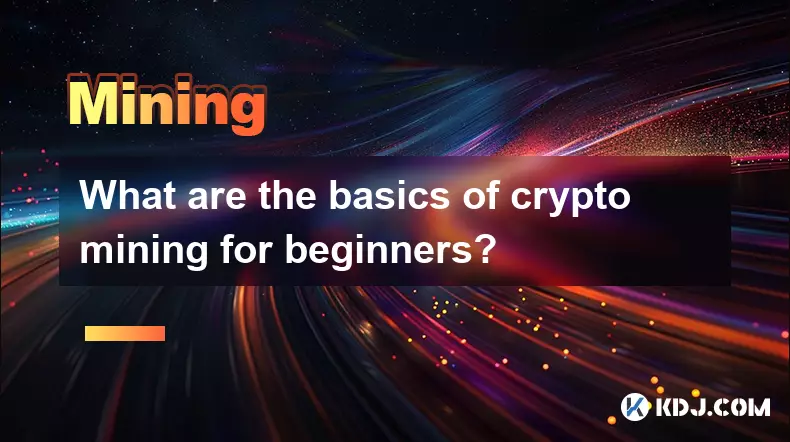-
 bitcoin
bitcoin $114320.977035 USD
-0.40% -
 ethereum
ethereum $4152.439985 USD
-1.75% -
 tether
tether $1.000111 USD
-0.04% -
 xrp
xrp $2.843037 USD
-1.63% -
 bnb
bnb $1013.349380 USD
-1.62% -
 solana
solana $208.362767 USD
-2.10% -
 usd-coin
usd-coin $0.999783 USD
0.00% -
 dogecoin
dogecoin $0.232559 USD
-1.00% -
 tron
tron $0.333491 USD
-1.09% -
 cardano
cardano $0.806310 USD
0.19% -
 hyperliquid
hyperliquid $45.023720 USD
-1.59% -
 ethena-usde
ethena-usde $1.000819 USD
-0.06% -
 chainlink
chainlink $21.241249 USD
-2.11% -
 avalanche
avalanche $30.035416 USD
-0.66% -
 stellar
stellar $0.364984 USD
-2.05%
What are the basics of crypto mining for beginners?
Crypto mining secures blockchain networks by solving complex puzzles, verifying transactions, and earning rewards—key to maintaining decentralization and trust in digital currencies.
Aug 31, 2025 at 08:36 am

Understanding the Core Concept of Crypto Mining
1. Crypto mining is the process by which new cryptocurrency tokens are introduced into circulation and transactions are verified and added to a blockchain ledger. Miners use powerful computers to solve complex cryptographic puzzles, a task that secures the network and ensures the integrity of transaction data.
2. The most well-known example is Bitcoin mining, which operates on a proof-of-work (PoW) consensus mechanism. In this system, miners compete to solve mathematical problems, and the first one to succeed gets the right to add a new block to the blockchain and receives a block reward in the form of newly minted coins.
3. Mining helps prevent double-spending, a critical issue in digital currencies where the same coin could potentially be spent more than once without a decentralized verification system. By validating transactions across a distributed network, mining maintains trust in the system without relying on a central authority.
4. The difficulty of mining adjusts over time based on the total computational power of the network. As more miners join, the puzzles become harder, ensuring that new blocks are added at a consistent rate regardless of network size.
5. Mining is not just about earning rewards; it’s a foundational element of blockchain security and decentralization. Without miners, most PoW-based cryptocurrencies would be vulnerable to attacks and transaction fraud.
Essential Equipment and Setup for New Miners
1. To begin mining, you need specialized hardware. Initially, people used regular CPUs and GPUs, but today, Application-Specific Integrated Circuit (ASIC) machines dominate the mining landscape, especially for Bitcoin. These devices are built solely for mining and offer significantly higher efficiency.
2. For cryptocurrencies like Ethereum (prior to its shift to proof-of-stake), GPU mining remained viable. Graphics processing units from manufacturers like NVIDIA and AMD are popular due to their ability to handle parallel computations required by certain hashing algorithms.
3. A stable internet connection is crucial. Mining requires constant communication with the blockchain network to receive new transaction data and broadcast solved blocks. Interruptions can result in missed rewards.
4. You’ll also need a cryptocurrency wallet to store your earnings. This wallet should support the specific coin you are mining and offer secure private key management. Hardware wallets are recommended for long-term storage.
5. Choosing the right mining rig depends on the coin you want to mine, your budget, and local electricity costs, which heavily influence profitability. Overheating and power surges are common risks, so proper ventilation and surge protection are necessary.
Joining Mining Pools and Managing Costs
1. Solo mining is rarely profitable for individuals due to the immense competition and computational power required. Most beginners join mining pools—groups of miners who combine their processing power to increase the chances of solving a block and share the rewards proportionally.
2. Mining pools charge a small fee, typically between 1% and 3%, for their services. Popular pools like F2Pool, Poolin, and Slush Pool provide user-friendly dashboards, real-time statistics, and reliable payout systems.
3. Electricity cost is the biggest ongoing expense in mining. Locations with cheap and stable power have a significant advantage. Running high-powered rigs continuously can lead to substantial energy bills, potentially outweighing profits if not carefully monitored.
4. Mining software must be configured correctly to communicate with your hardware and the chosen pool. Examples include CGMiner, BFGMiner, and EasyMiner, each supporting different devices and protocols. Incorrect settings can lead to reduced efficiency or hardware damage.
5. Profitability calculators are essential tools that estimate returns based on hash rate, power consumption, electricity price, and current coin value. These tools help miners make informed decisions before investing in equipment.
Frequently Asked Questions
What happens if the value of the mined cryptocurrency drops?A sharp decline in coin value can turn a profitable mining operation into a loss-making one, especially if electricity and hardware costs remain constant. Miners may choose to continue operating to cover fixed costs or shut down rigs temporarily until market conditions improve.
Can I mine cryptocurrency using my home computer?While technically possible for some lesser-known coins, home computers lack the processing power to compete in major networks like Bitcoin. The electricity consumed would likely exceed any potential earnings, making it impractical for serious mining.
Is crypto mining legal everywhere?Mining legality varies by country. It is fully legal in regions like the United States and Canada but restricted or banned in others such as China and Egypt. Always check local regulations before setting up mining operations.
How do I track my mining performance?Most mining software and pools offer dashboards that display hash rate, uptime, accepted/rejected shares, and estimated earnings. Monitoring these metrics helps identify hardware issues and optimize performance over time.
Disclaimer:info@kdj.com
The information provided is not trading advice. kdj.com does not assume any responsibility for any investments made based on the information provided in this article. Cryptocurrencies are highly volatile and it is highly recommended that you invest with caution after thorough research!
If you believe that the content used on this website infringes your copyright, please contact us immediately (info@kdj.com) and we will delete it promptly.
- BlockDAG, DOGE, HYPE Sponsorship: Crypto Trends Shaping 2025
- 2025-10-01 00:25:13
- Deutsche Börse and Circle: A StableCoin Adoption Powerhouse in Europe
- 2025-10-01 00:25:13
- BlockDAG's Presale Buzz: Is It the Crypto to Watch in October 2025?
- 2025-10-01 00:30:13
- Bitcoin, Crypto, and IQ: When Genius Meets Digital Gold?
- 2025-10-01 00:30:13
- Stablecoins, American Innovation, and Wallet Tokens: The Next Frontier
- 2025-10-01 00:35:12
- NBU, Coins, and Crypto in Ukraine: A New Yorker's Take
- 2025-10-01 00:45:14
Related knowledge

The difference between staking and mining
Sep 24,2025 at 05:18am
Understanding Staking in the Cryptocurrency Ecosystem1. Staking involves holding funds in a cryptocurrency wallet to support the operations of a block...

How to participate in testnet mining?
Sep 22,2025 at 09:18am
Understanding Testnet Mining in the Crypto Ecosystem1. Testnet mining is a method used by blockchain developers to simulate real-world conditions on a...

How to dispose of abandoned mining machines?
Sep 19,2025 at 08:19pm
Assessing the Condition of Abandoned Mining Rigs1. Begin by inspecting each mining machine for visible damage, corrosion, or missing components. Machi...

How to identify high-quality mining pools?
Sep 21,2025 at 03:19pm
Reputation and Track Record1. A mining pool’s reputation is built over time through consistent performance and transparency. Pools that have operated ...

Advantages of decentralized mining pools
Sep 20,2025 at 04:36pm
Enhanced Security and Resistance to Censorship1. Decentralized mining pools operate on blockchain-based smart contracts, eliminating the need for a ce...

What is mining machine overclocking?
Sep 21,2025 at 07:19pm
Understanding Mining Machine Overclocking1. Mining machine overclocking refers to the process of increasing the operating frequency of a cryptocurrenc...

The difference between staking and mining
Sep 24,2025 at 05:18am
Understanding Staking in the Cryptocurrency Ecosystem1. Staking involves holding funds in a cryptocurrency wallet to support the operations of a block...

How to participate in testnet mining?
Sep 22,2025 at 09:18am
Understanding Testnet Mining in the Crypto Ecosystem1. Testnet mining is a method used by blockchain developers to simulate real-world conditions on a...

How to dispose of abandoned mining machines?
Sep 19,2025 at 08:19pm
Assessing the Condition of Abandoned Mining Rigs1. Begin by inspecting each mining machine for visible damage, corrosion, or missing components. Machi...

How to identify high-quality mining pools?
Sep 21,2025 at 03:19pm
Reputation and Track Record1. A mining pool’s reputation is built over time through consistent performance and transparency. Pools that have operated ...

Advantages of decentralized mining pools
Sep 20,2025 at 04:36pm
Enhanced Security and Resistance to Censorship1. Decentralized mining pools operate on blockchain-based smart contracts, eliminating the need for a ce...

What is mining machine overclocking?
Sep 21,2025 at 07:19pm
Understanding Mining Machine Overclocking1. Mining machine overclocking refers to the process of increasing the operating frequency of a cryptocurrenc...
See all articles










































































